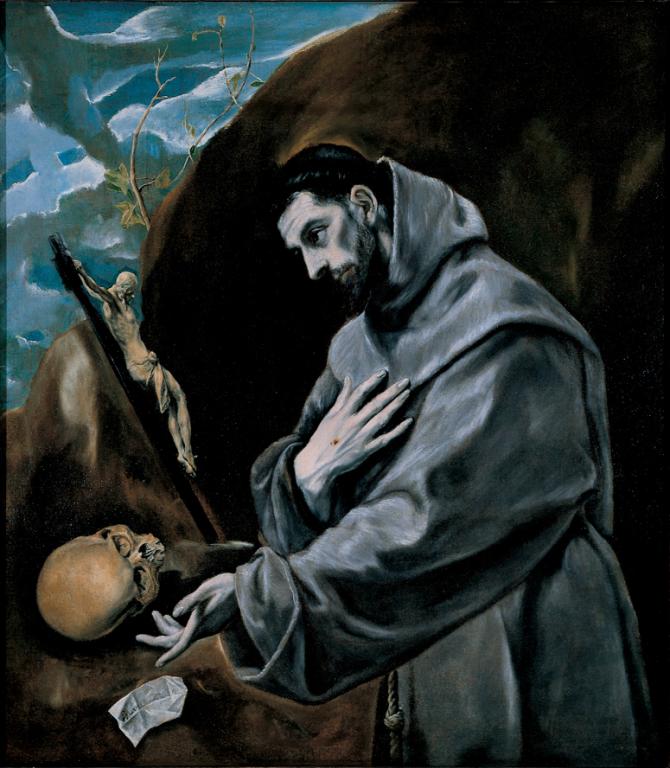It would be hard to find a more universally popular figure than Francis of Assisi. Christians and non-Christians alike commonly recall him as a wonderful figure of holiness, fully in tune with the animal kingdom, and the environment. It’s odd then to recall a time when Francis was the centerpiece of what we can best call a dreaded messianic cult, which the Church suppressed with a great deal of bloodshed. This was one of the gravest political and spiritual crises that the Latin Church suffered before Luther’s Reformation itself, two centuries afterwards. And the crisis of these years often foreshadows that later revolution.
After Francis’s death in 1226, the order founded in his name became increasingly divided, as dissidents protested that both the order and the church had compromised far too much with worldliness and wealth. As controversies grew, the pro-poverty faction became increasingly disaffected from the wealth of the church itself. One radical brother named Petrus Iohannis Olivi framed the conflict in cosmic terms in a commentary on the Book of Revelation that would provide a kind of revolutionary manual for generations to come. Like many before and since, “Peter John” divided the ages of history into particular eras, with the lesson that we were now living in the last times, a Sixth Age, before the final Judgment of the Seventh. He treated Francis as a heavenly figure, the new Elijah, “who is, after Christ and under Christ, the first and principal founder and initiator and exemplar of the sixth period and its evangelical [gospel] rule.” That age should begin properly with the destruction of the Great Whore Babylon, which signified the hierarchical Church.
From the end of the thirteenth century, the church increasingly condemned and stigmatized these Little Brothers (Fraticelli), who were driven underground. The movement found sympathy from pious lay believers variously known as Beguins or Beghards, who followed lives of strict piety, of prayer, poverty, and good works, whether living as hermits or in small communities. They termed themselves “poor brothers of penitence of the third order of Saint Francis.” In 1311-12, the Council of Vienne condemned “an abominable sect of wicked men, commonly called Beghards, and of faithless women, commonly called Beguines, [which] has sprung up in the realm of Germany.”
Matters were already very tense in the early 1300s, when Europe and much of the world crashed into the Little Ice Age, as I describe in my current book, Climate, Catastrophe, and Faith: How Changes in Climate Drive Religious Upheaval. As has occurred before and since, extreme climate instability detonated social crises, and religious movements of all kinds – pogroms and persecutions, revivals and messianic movements, and apocalyptic upsurges. But rarely were conditions as dreadful as in the decade after 1314, when societies around the world were devastated by brutal famines and epidemics.
For dissidents and persecutors alike, the grim new world dramatically sharpened the existing conflicts. Both sides knew that judgment was near, and that God’s anger could only be appeased by fighting his earthly enemies. Of course, intolerance was nothing new to Latin Europe, but violent heresy-hunting now escalated in degree and character, and especially in those hideous years after 1314. In the desperation of the times, believers espoused more fervent and perfectionist views and practices, regardless of official church doctrine. On the other side, those authorities were ever more sensitive to suppress heresies, which they believed aggravated the assaults of hunger and disease. As positions hardened, each side denounced the other in literally apocalyptic terms, and looked to the imminent end times.
One key source for the religious currents of the age is the Inquisitor Bernard Gui, who around 1323 compiled a sweeping Manual, the Practica Inquisitionis Heretice Pravitatis – the Conduct of Inquiry Concerning Heretical Depravity. Of the Beguins, he wrote that
Their erroneous opinions began to be exposed around the year of our Lord 1315, more or less, although they were considered suspect by many even earlier. During the following years, in the provinces of Narbonne, Toulouse and Catalonia, many of them were seized, held in custody and, their errors having been detected, many of both sexes were judged heretical and burned.
Persecution grew still more severe from 1317, when the new Pope John XXII decided to intervene decisively on the side of the Franciscan order against the Fraticelli.By 1318, recalcitrant brothers were being burned alive. In modern times, the Fraticelli conflict supplies the background to Umberto Eco’s celebrated novel The Name of the Rose.
But imposing order was no simple task at a time of very widespread popular discontent, and disaffection. Franciscan dissidents gained wide public admiration and sympathy because of their obvious piety, which promised to please God and even reduce his obvious fury against the human race. The Fraticelli became an underground sect, with all the internal wrangling and fragmentation that implies, and all the rivalry of emerging leaders. One of the articles invoked against the Beguins was that they not only sympathized with these suffering Little Brothers, but actively regarded them as God’s holy martyrs, victim of an evil church order. They, in fact, and not the church hierarchy, were true Catholics. Beguines meanwhile formed their own kind of underground resistance, which helped Fraticelli escape the Inquisition, and to flee to safer lands. The Fraticelli/Beguin networks constituted a clandestine church, with its own hierarchy.
Although the Franciscan conflict might seem like an internal affair within the clergy – what moderns insultingly dismiss as “just theological” – it actually became a divisive issue in international affairs, as Europe’s rival powers became deeply involved in the controversy, siding with one or other church faction. So did rival claimants to the Holy Roman Empire. Resulting controversies continued well into the fifteenth century, and there were mass burnings of Fraticelli in the 1420s.
As the advocates of poverty were hunted and persecuted, they turned vigorously to scripture, and above all the Book of Revelation. As they faced torture and execution, Fraticelli leaders naturally turned to the church’s apocalyptic traditions, presenting themselves as the persecuted true followers of Christ facing the fearsome powers of the Beast, in an age of cosmic agony and violence. They had a natural affinity for the commentaries of Peter John Olivi. Giving added credence to such ideas was the fact that since 1309, the Pope and the Papal court were located not in Rome but in the city of Avignon, under French power. In radical visions, Avignon became Babylon, the city of exile and seat of evil, with all the implications derived from Revelation.
Making the Beguins particularly suspect was the group’s fascination with Revelation, which they read in Latin and – far more suspect – in the vernacular, and they accompanied that with special commentaries. The Beguins turned lovingly to Peter John Olivi, who (they thought)
had knowledge through revelation given him by God, especially in his commentary on the Apocalypse. They also derive the aforesaid errors and opinions from oral tradition, teachings which they say he imparted to his close associates and to the Beguins during his lifetime, and which were then recited to others by those who originally received them.
Like the Fraticelli, the Beguins held that “the carnal church (that is, the Roman Church) was Babylon the Great Whore which was to be destroyed and cast out just as the synagogue of the Jews was when the primitive church began.” Reputedly, the movement dreamed of a glorious event to occur on the 1300’s anniversary of Christ’s Resurrection – in 1333 – when Muslims would be converted, Antichrist (the Papacy) would fall, and when Christ and Francis would reappear together in glory to establish God’s kingdom on earth. When Bernard Gui advised inquisitors how to seek out these perilous ideas, he urged them to begin by asking just what suspects knew about Olivi and his readings of Revelation.
By 1320, the Book of Revelation stood at the center of Latin Europe’s religious and political struggles. That was neither the first time nor the last that catastrophic climate change would make the apocalypse a very present reality for ordinary people. It’s a dramatic story in its own right. But who would have thought that St. Francis would be central to it, as a wished-for messiah? We are a long way from the man who chatted to birds and animals.
It is also a classic case-study of how climate-driven disasters drive apocalyptic movements.
David Burr has a notable book on The Spiritual Franciscans: From Protest to Persecution in the Century After Saint Francis (Penn State Press, 2001).














